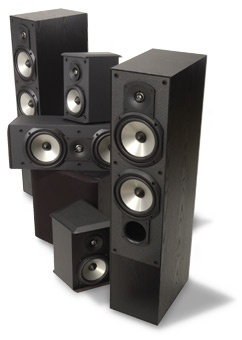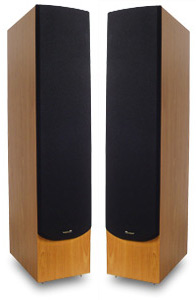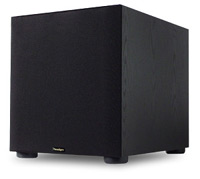
|


Paradigm
System Three.2
Home-Theater Speaker System
|
|
|
 |

Description Model:
Phantom v.3 speakers
Price: $529 USD per pair
Dimensions: 37"H x 7.75"W x 12.6"D
Weight: 33 pounds each
Model: CC-270 v.3 center-channel speaker
Price: $279 USD
Dimensions: 7.5"H x 22.75"W x 10.25"D
Weight: 20 pounds
Model: ADP-170 v.3 surround speakers
Price: $449 USD per pair
Dimensions: 10.75"H x 9.5"W x 6.6"D
Weight: 12 pounds each
Model: PDR-12 subwoofer
Price: $419 USD
Dimensions: 16.25"H x 14.5"W x 19"D
Weight: 41 pounds
System Price: $1676 USD
Warranty: Five years on speakers, three
years on subwoofer amplifier |

Features
- 6.5" metallescent polymer-cone woofers (Phantom v.3 and
CC-270 v.3)
- 5.5" metallescent polymer-cone woofers (ADP-170 v.3)
- .75" ceramic/metal composite-dome tweeters (ADP-170
v.3, Phantom v.3)
- 1" ceramic/metal composite-dome tweeter (CC-270 v.3)
- Adapted Dipole surround speakers (ADP-170 v.3)
- Video shielding (CC-270 v.3)
- 12" driver (PDR-12)
- 110W amplifier (330W peak) (PDR-12)
- Adjustable crossover (PDR-12)
- Adjustable spikes (Phantom v.3)
- Light-cherry, black-ash, or rosenut laminate finishes
|
Paradigm is one of the largest
speaker manufacturers in the world, which you may have already known. What you may not
know is that they rely heavily on their modern, comprehensive testing facilities. This
Canadian company spends a lot of time and effort in research and development -- testing
speakers, individual drivers, and crossover components, all of which are made in its
Mississauga, Ontario facility. The result of all this research and development is a
mind-boggling array of home-theater speakers and subwoofers, spanning all price ranges.
Whatever your budget is, chances are, Paradigm has a home-theater system for you.
Paradigm has completely revamped their popular Performance
speaker line. The system that Paradigm sent Home Theater & Sound is the System
Three.2, listing for $1676 USD. As you will see, performance is an appropriate
description for this system.
Introducing the System Three.2
Opening up this Paradigm system was pure joy. Each main
speaker came in solid, corrugated cardboard with its own unpacking instructions! Although
this may not seem like a big deal, Paradigm should be commended for easing the
sometimes-painful hassle of unpacking tall, unwieldy speakers.
 Once removed, the tallest box revealed one great-looking speaker -- the Phantom
v.3. With a narrow front baffle of 7.75" and 37" in height, the Phantom
v.3’s elegant proportions did not dominate my medium-sized room. The fit and finish
are superb -- my samples came in light-cherry laminate, among the best that I have ever
seen. The removable front grille is attractively styled with a curved bottom. Behind the
grille is a dark-gray front baffle where the drivers are mounted. The Phantom v.3, like
all Paradigm speakers, is designed to work best with the grilles on. This is a good idea
if you have kids running around with scissors (which is not a good thing for numerous
reasons!). The bad thing is that you may be tempted to leave the grilles off, since the
drivers are so attractive. Once removed, the tallest box revealed one great-looking speaker -- the Phantom
v.3. With a narrow front baffle of 7.75" and 37" in height, the Phantom
v.3’s elegant proportions did not dominate my medium-sized room. The fit and finish
are superb -- my samples came in light-cherry laminate, among the best that I have ever
seen. The removable front grille is attractively styled with a curved bottom. Behind the
grille is a dark-gray front baffle where the drivers are mounted. The Phantom v.3, like
all Paradigm speakers, is designed to work best with the grilles on. This is a good idea
if you have kids running around with scissors (which is not a good thing for numerous
reasons!). The bad thing is that you may be tempted to leave the grilles off, since the
drivers are so attractive.
A .75" ceramic/metal composite-dome (CMC) tweeter sits
near the top of the v.3’s front baffle. Directly below the tweeter are two 6.5"
metallescent polymer-cone (MPC) woofers. As I learned from Paradigm,
"metallescent" means that the polymer cone is embedded with metal pigments to
give the driver low mass with high stiffness, resulting in greater midrange clarity over
standard polypropylene woofers. Below the lower 6.5" woofer is a large
3"-diameter front port, allowing easy placement near rear walls. The Paradigm Phantom
v.3 has a single set of gold-plated binding posts in the back. According to Paradigm, the
rated sensitivity is 91dB "in-room" with impedance "compatible with 8
ohms." With these specifications, you’d think these speakers would be easy loads
to drive with modest amplification. With my 60Wpc Outlaw Model 1050 receiver, this was
indeed my experience.
The center-channel in the Paradigm System Three.2 is the
CC-270 v.3, the largest of three center-channel speakers in the Performance line. The
CC-270 v.3 is big, nearly spanning the width of my 32" TV. The speaker’s
downward-sloping top is finished in a matte-black finish, called "black
graphite" by Paradigm. The drivers are the same as in the Paradigm Phantom v.3, with
two 6.5" metallescent polymer-cone woofers on either side of a 1" ceramic/metal
composite-dome tweeter. Around back is a single set of gold-plated binding posts and a
2.5"-diameter port.
The ADP-170 v.3 performs surround duties in the Paradigm
System Three.2. This speaker is a bit of a departure for Paradigm, with a slight wedge
shape rather than the rectangular box shape of their other surround speakers. On each
angled baffle is a .75" CMC tweeter and a 5.5" MPC woofer. ADP stands for
"adapted dipole." It differs from a conventional dipole by operating out of
phase (like a conventional dipole speaker) above the crossover frequency of 2kHz, and
operating in phase below the crossover frequency (like a bipole speaker). What this design
achieves is a speaker that produces a diffuse soundfield with better bass response than a
conventional dipole speaker, since the woofers operate in phase.
Paradigm supplied the PDR-12 subwoofer with this system.
This subwoofer looks compact from the front, though it is quite deep. The finish on the
subwoofer was black ash. The PDR-12 automatically turns on when a signal is detected, and
an amber-colored LED below the Paradigm logo on the non-removable front grille lights up
when a signal is detected. Around back, the PDR-12 has controls for subwoofer volume level
and crossover frequency. It has a mono line-level input, and left and right speaker-level
inputs and outputs. The speaker connections are spring clips so make sure you use
small-diameter speaker wire if you are using these connections. The PDR-12 contains an
amplifier rated for 110W nominal and 330W peak output. The driver is a single
forward-firing 12" carbon-fiber-reinforced composite-cone woofer. Two large 3"
ports vent the PDR-12.
Paradigm System Three.2 home-theater performance
Since the Paradigm Phantom v.3 has a compact footprint, I
was able to place the speakers in the positions that typically work best in my family
room. With slight toe-in adjustments, I have found that the following placement works
best, and this case was no exception. The front left and right speakers were placed
9’ away from my listening seat, at 30-degree angles relative to the center of the TV,
while the surrounds were 6’ away, 90 degrees relative to the center of my TV. The
center-channel was placed on top of my 32" direct-view TV, and the subwoofer sat
adjacent to the front left speaker.
The Paradigm System Three.2 has so many impressive
attributes, but I’ll start with the one that stood out most for me: superb imaging.
I’m not talking just about imaging between the front speakers, but imaging between
the front and surround speakers. This was clearly evident to me while watching the DVD Kiss
of the Dragon. This Jet Li film is an extremely violent martial arts showcase, but it
has good sound that I find quite useful for evaluating audio gear. In chapter 10, an
undercover agent is walking in and out of a room, and his voice is easy to follow between
the left front Phantom v.3 and the left rear ADP-170 v.3. Impressively, as the voice moved
from left front to the left rear, the tonality did not shift, a difficult achievement
given the position of each speaker. Another example of this side imaging occurs in chapter
9 of Rush Hour 2. There is a subtle tinkling sound to the right side of the
soundstage, between the right front and right rear speakers. The Paradigm system pulled
off this sonic feat, which drew me into the scene.
The Paradigm System Three.2 showed off another cool trick:
rear-channel imaging. This one occurred during chapter 18 from Kiss of the Dragon.
In a scene with bullets flying, I could hear distinct bullet shells hitting the floor, directly
behind me. This was without a center surround active. Very impressive!
The Paradigm System Three.2 also excelled in surround
envelopment. In chapter 10 from Rush Hour 2, Alan King is opening a new casino. The
Paradigm system provided a good sense of the room’s space, with the reverberation of
the room expressed nicely by all five of the speakers. In chapter 15 of Fight Club,
the scene shifts from the bar on the main floor to the stark, basement fight club. The
Paradigm System Three.2 portrayed these diverse environments with ease, from the
relatively dead walls of the bar to the reverberant walls of the basement.
Another terrific performer in the Paradigm System Three.2
is the center-channel CC-270 v.3. Throughout the DVD Moulin Rouge, Nicole
Kidman’s surprisingly good singing voice sounded beautiful through the center
speaker. Whether Kidman sang softly or loudly, the CC-270 v.3 conveyed the subtleties of
her voice effortlessly. Male voices, such as George Clooney (actually Dan Tyminski)
singing in O Brother, Where Art Thou? did not exhibit any chestiness or hollowness,
which are annoying traits I often hear in other center-channel speakers.
There was seamless timbre matching between the CC-270 v.3
and the main Phantom v.3 speakers. Listening to chapter 2 from Man on the Moon, Jim
Carey’s voice sounded identical as it pops from the left front speaker to the
center-channel. Another example of this is in chapter 6 of Memento, where a phone
ring jumps from the left front speaker to the center-channel. The ringing sounded identical
in both the CC-270 v.3 and the Phantom v.3.
The Paradigm System Three.2 had exceptional performance all
around, including the all-important subwoofer. Paradigm has kept the PDR-12 for years, and
hasn’t found the need to upgrade it. After my audition, I can see why -- this is an
excellent subwoofer! With its 12" driver and two huge rear-firing ports, the PDR-12
provides pants-flapping bass that played louder in my medium-sized room than even I could
bear. In chapter 20 of Star Wars Episode 1: The Phantom Menace, the LFE channel
gets a workout during the pod-racing scene. The PDR-12 shook my floor as the pod racers
screamed around the course. Another room-shaking scene is in chapter 13 from Dinosaur.
In the first chapter, the T-Rex chases and catches a much smaller dinosaur. His (I’m assuming
the T-Rex is a male) foot stomps filled my family room with sub-35Hz bass, without
overhang or boominess. The performance of the Paradigm PDR-12 puts many more expensive
subwoofers that I’ve heard to shame.
Comparison
Another similarly priced system that I’ve had a chance
to audition is the Dahlquist
System 4. This system retails for $1650, and consists of the following speakers: the
QX8 main speakers, the QX50C center-channel, the QX4 monopole rear speakers, and the
QX125S subwoofer. The Dahlquist System 4 is a very close match to the Paradigm System
Three.2 in terms of price and size.
When comparing the two systems, I immediately noticed that
both have significantly different tonal balances. The Paradigm Phantom v.3 sounds slightly
darker, but had a more accurate midrange compared to the Dahlquist QX8. This was
noticeable when listening to Diana Krall’s The Look of Love [Verve
3145498462]. In the opening cut, "S’Wonderful," the Dahlquist QX8 imparted
airiness to the orchestral strings that the Paradigm could not quite match. In contrast,
the Paradigm Phantom v.3’s seductive midrange made Diana Krall’s voice
especially appealing.
I preferred the Paradigm Phantom v.3’s excellent
midrange performance to that of Paradigm’s more expensive first-generation Monitor 9.
I owned a Paradigm home-theater system based on the Monitor 9 for a few years, and one
lasting memory of that speaker is its overly warm tonal balance. This was evident when
listening to "Hotel California" from the Eagles’ DVD Hell Freezes Over.
Don Felder’s guitar playing had warmth that was a bit too syrupy for my tastes. With
the Paradigm Phantom v.3, however, the sound of his guitar sounded more accurate to my
ears.
Another difference between the Paradigm System Three.2 and
the Dahlquist System 4 was in the off-axis response from the center-channel. With the
Paradigm CC-270 v.3, sitting to the sides of the room did not result in significant tonal
differences in voice when compared to sitting in the ideal listening position in the
center of the room. However, the Dahlquist QX50C suffered from rolled-off high frequencies
off axis that were not evident when listening to the on-axis sound. This was noticeable
when listening to Clooney/Tyminski’s voice in O Brother, Where Art Thou? Off
axis, it sounds closed-in compared to the on-axis sound.
 In terms of surround sound, the
Paradigm ADP-170 v.3 managed to sound equally good when asked to provide surround
envelopment or discrete surround effects. In contrast, the Dahlquist QX4 did not reproduce
surround envelopment quite as well as the Paradigm ADP-170 v.3. I noticed this while
watching the DVD Unbreakable. In chapter 22, Bruce Willis struggles underwater, and
the sound of the water pans from front to back. With the Paradigm ADP-170 v.3, the sound
of the water is continuous, but with the Dahlquist QX4, there is an audible gap between
the front and the surround speakers. In terms of surround sound, the
Paradigm ADP-170 v.3 managed to sound equally good when asked to provide surround
envelopment or discrete surround effects. In contrast, the Dahlquist QX4 did not reproduce
surround envelopment quite as well as the Paradigm ADP-170 v.3. I noticed this while
watching the DVD Unbreakable. In chapter 22, Bruce Willis struggles underwater, and
the sound of the water pans from front to back. With the Paradigm ADP-170 v.3, the sound
of the water is continuous, but with the Dahlquist QX4, there is an audible gap between
the front and the surround speakers.
Comparing subwoofers, the Paradigm PDR-12 excelled in
producing huge amounts of bass. Although the Dahlquist QX125S is a good performer, when I
cranked-up the volume during the opening scene from the DVD Dinosaur, the Paradigm
PDR-12 moved my walls better than any inexpensive sub that I’ve had in my home. The
foot stomps of the T-Rex were visceral with the Paradigm PDR-12. The Dahlquist QX125S
could not match the Paradigm in this regard.
Conclusion
The Paradigm System Three.2 excels in many areas, such as
purity of midrange, surround envelopment, and deep bass that you can feel. From its great
looks to its great sound, there is little to fault with this system. Although you could
spend much more and may get better performance, the Paradigm System Three.2 offers
great sound at a remarkable list price of just $1676. If your room is medium sized, you
may question your need to spend more, as I did. The Paradigm System Three.2 gets my
highest recommendation.
| Review
System |
| Receiver - Outlaw Model 1050 |
| Sources
- JVC XV-721 DVD player, Pioneer Elite PD-65 CD player, Rega Planar 3 turntable
with Grado Prestige Silver cartridge |
| Cables - Sonic Horizons |
| Monitor
- JVC 32" direct-view TV |
|
|

